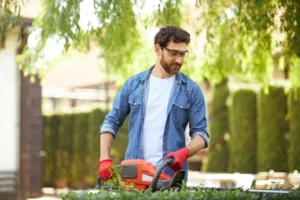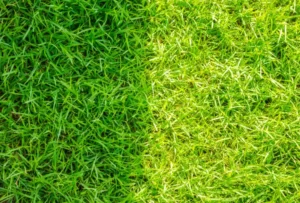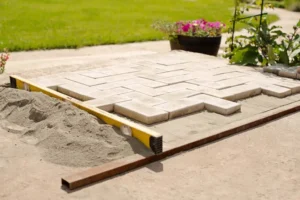Why does my landscape fabric hold water? Landscape fabric is a commonly used material in gardening and landscaping, designed to suppress weeds while allowing air and water to pass through to the soil below. It’s often seen as a low-maintenance solution for keeping gardens neat and healthy.
But what happens when it starts holding water instead of letting it drain? That’s when problems arise. If you’ve noticed puddles forming or overly soggy soil beneath your mulch, you might be dealing with landscape fabric holding water a frustrating and unexpected issue for many gardeners.
In this article, we’ll dive into the reasons behind this problem, explore the disadvantages of excess water retention, highlight common misuses of landscape fabric that can lead to drainage issues,and provide some useful substitutes to support the success of your garden.
Why Does My Landscape Fabric Hold Water?

If you’re finding puddles or excess water collecting on your landscape fabric, you’re not alone. Many gardeners ask, Does water go through landscape fabric? or “Is landscape fabric water permeable?” The response is contingent on a number of important factors:
Poor Quality or Incorrect Type of Fabric
The type of landscape fabric you use plays a major role in water permeability.
- Non-woven vs. Woven Fabric Differences: Non-woven fabrics are typically made from bonded synthetic fibers and are often less permeable, especially the cheaper varieties. Woven fabrics, on the other hand, are made with crisscrossed fibers that allow more water to seep through ideal for situations where drainage is important.
- How Cheap or Plastic Fabrics Impede Drainage: Budget or plastic-like landscape fabrics often lack sufficient pores for water to pass through. These fabrics can act more like tarps than garden aids, trapping water instead of letting it flow. So if you’re asking, Is landscape fabric water permeable? some are, but not all.
Clogged Fabric Over Time
Even high-quality landscape fabric can become less permeable over time.
- Debris, Soil, and Mulch Buildup: Fine particles from soil and mulch can accumulate on the fabric’s surface or within its pores, reducing its ability to drain properly.
- Organic Matter Decomposition Leading to Blockage: Decomposing mulch or plant debris can form a sludge-like layer, clogging the fabric and turning it from permeable to nearly waterproof. Over time, even fabrics marketed as water-permeable may lose functionality.
Improper Installation
Incorrect installation can compromise even the best materials.
- No Slope or Grading: Water needs a path to flow. If your fabric is laid on flat or low areas without proper grading, water will pool regardless of the fabric’s permeability.
- Fabric Placed Too Deep or Covered Incorrectly: Burying fabric under too much mulch or soil can compress it and prevent water from reaching the ground below. It’s essential to follow manufacturer recommendations for layering and depth.
Overcompaction of Soil Beneath Fabric
Even if water gets through the fabric, the underlying soil must be able to absorb it.
- How This Reduces Permeability: Compacted soil has fewer air pockets, which drastically reduces water infiltration. Water may collect on the surface simply because it has nowhere else to go.
- The Impact of Machinery or Foot Traffic: Regular walking pathways or repeated pressure from heavy machinery can flatten the soil underneath the fabric. This creates a hard barrier, defeating the purpose of using a permeable material.
You can also read about bay area landscape construction service.
The Disadvantages of Landscape Fabric
While landscape fabric is often marketed as a low-maintenance solution for weed control, it comes with several drawbacks that can affect long-term garden health and functionality. Let’s break down the key disadvantages:
Poor Water Drainage Over Time
One of the biggest issues with landscape fabric is its declining drainage ability. Even if you start with water permeable landscape fabric, its effectiveness can diminish due to debris, soil, and organic matter clogging the material. This often leads gardeners to question, “Is landscape fabric water permeable?” and while it might be at first, that permeability often reduces over time, leading to pooling water and root rot.
Weed Growth Around Edges or Through Holes
Landscape fabric isn’t a permanent weed blocker. Over time, weeds can sneak in through the edges, seams, or any holes made for planting. As mulch breaks down or blows away, weed seeds have a better chance of establishing themselves right on top of the fabric, making your garden look messy and defeating the purpose of installation.
Difficult to Remove or Replace
Once installed, landscape fabric can be a headache to take out. Roots may grow through it, mulch settles on top, and over time, it starts to disintegrate—turning removal into a frustrating, labor-intensive task. This makes it challenging to refresh your garden layout or improve the soil underneath.
Harm to Soil Health and Earthworms
Landscape fabric restricts the natural flow of air and water, which can hurt soil health. Earthworms and beneficial microbes struggle to thrive in soil covered by synthetic barriers. Even water permeable landscape fabric can limit oxygen exchange, leading to compacted, lifeless soil over the years.
Mulch Breakdown Becomes Muck
Organic mulch is supposed to decompose slowly into the soil, improving fertility. But when mulch sits on top of fabric, it breaks down into a soggy, mucky layer that doesn’t enrich the soil. Instead of benefiting your garden, it creates a mess and further clogs the fabric.
you can read about Garden Fences
Four Most Common Misuses of Landscape Fabric

While landscape fabric can help with weed control and erosion prevention, it’s often misused in ways that reduce its effectiveness or even create bigger problems. Here are the most common mistakes gardeners make, and how they relate to drainage, durability, and garden health.
Using Fabric Under Organic Mulch
Many gardeners install landscape fabric beneath organic mulch like bark or wood chips, thinking it will prevent weeds and improve garden performance. However, in practice, this arrangement frequently backfires.
- The mulch decomposes on top of the fabric, creating a soggy, compacted layer that holds moisture.
- Instead of improving soil, the decaying mulch can cause unpleasant smells, root rot, and over time landscape fabric holding water where it should be draining.
Even water permeable landscape fabric can clog under these conditions, especially without regular maintenance.
Installing on Flat, Poorly Drained Areas
Drainage is critical in any garden design. Placing landscape fabric on flat ground without proper grading means water has nowhere to go.
- Without a slope to guide runoff, water accumulates, leading to saturated soil or standing water.
- This results in landscape fabric holding water, which stresses plant roots and encourages mold or mildew.
Even the most water permeable landscape fabric can’t overcome poor site design—drainage planning is essential.
Using the Wrong Type for the Job
Not all landscape fabrics are created equal. A big mistake is using the wrong type of fabric for your specific needs.
- Commercial-grade fabric is designed for long-term durability and heavier-duty use think under gravel or in hardscaping.
- Garden-grade fabric is lighter and may not hold up well under heavy mulch or traffic.
Using a low-quality or inappropriate fabric often leads to faster clogging and poor drainage, again resulting in landscape fabric holding water or failing to suppress weeds effectively.
Ignoring Long-Term Maintenance
Like any garden tool or product, landscape fabric requires upkeep. Many people forget to check for:
- Debris buildup
- Mulch decomposition
- Soil compaction or shifting
Without maintenance, even water permeable landscape fabric becomes ineffective, causing drainage problems and weed growth. Inspecting your landscape fabric seasonally can help you catch issues early and prolong its life.
You can also read about What Is The Best Landscape Fabric That Lets Water Through?
Are There Alternatives to Landscape Fabric?
Yes there are several effective alternatives to landscape fabric that can offer better drainage, soil health, and long-term weed control without the downsides of synthetic barriers. Here are some of the best options:
Mulch Alone (Organic or Inorganic)
A thick layer of mulch—wood chips, bark, straw, or even rubber—can suppress weeds, retain moisture, and improve soil over time. Unlike fabric, organic mulch breaks down and enriches the soil, though it may need to be replenished more often.
Cardboard or Newspaper Layering
This eco-friendly method involves layering plain cardboard or several sheets of newspaper under mulch. It smothers weeds and slowly decomposes, improving soil structure while still allowing water and air to pass through something water permeable landscape fabric often fails at over time.
Living Ground Covers (Like Clover, Creeping Thyme)
Low-growing ground cover plants are a natural weed barrier. They look great, improve biodiversity, and maintain healthy, breathable soil without trapping moisture or heat the way synthetic fabrics can.
Permeable Landscape Membranes or Grid Systems
These modern alternatives are engineered to allow water and air flow while providing weed suppression and erosion control. If you’re wondering whether landscape fabric holding water is a problem, these materials are designed to prevent exactly that.
Gravel or Rock Mulch with Weed Barrier Underlay (Selectively)
For dry areas or decorative landscapes, a layer of gravel or rock over a high-quality, water permeable landscape fabric or mesh can work well especially in low-plant zones like pathways or xeriscapes. Just avoid using this combo in garden beds, as it can trap heat and block nutrients.
you can read about How to Install Landscape Fabric Underneath Rocks
Final Thoughts
If you’ve ever wondered, Why does my landscape fabric hold water? it’s likely due to clogged fabric, poor installation, or using the wrong material. Even water permeable landscape fabric can lose its effectiveness over time if not maintained properly. To avoid these issues, make sure you’re using the right fabric and checking for blockages. If you need professional help with your landscaping, Lakota Design Group is here for you. Contact us today for expert advice and service, and let us help you create a beautiful, functional outdoor space!
FAQs
Why Does My Landscape Fabric Hold Water Instead Of Draining?
Landscape fabric may hold water if it becomes clogged with debris, soil, or decomposed organic matter. Even water permeable landscape fabric can lose its ability to drain properly over time if it’s not regularly maintained.
How Can I Prevent Landscape Fabric From Holding Water?
To prevent landscape fabric from holding water, make sure it’s installed on a graded surface that allows for proper drainage. Additionally, using the right type of fabric for your soil and regularly checking for blockages can help maintain water flow.
Does Water Permeable Landscape Fabric Really Work?
Yes, water permeable landscape fabric is designed to allow water to pass through while blocking weeds. However, it can lose effectiveness over time if clogged with debris or if not installed correctly.
Can I Use Landscape Fabric In Areas With Poor Drainage?
Landscape fabric can be problematic in poorly drained areas. Without proper grading or a slope, water may accumulate on top of the fabric. It’s important to ensure adequate drainage when using landscape fabric.
How Often Should I Maintain Landscape Fabric To Prevent Water Retention?
Regular maintenance is essential. Check your landscape fabric for signs of clogging, debris buildup, or compaction at least once a year, especially after heavy rain or mulching.





